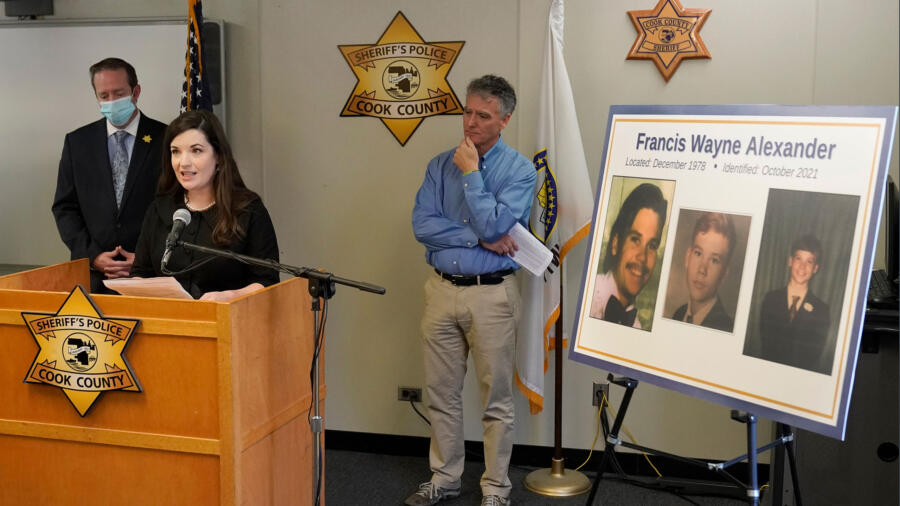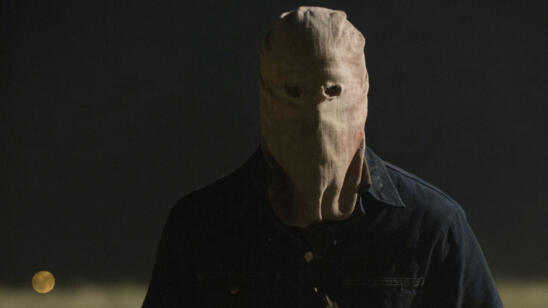The DNA Doe Project works on identifying John and Jane Does using investigative genetic genealogy. The nonprofit has a network of volunteers who have successfully identified the remains of more than 70 people since 2017. In October 2021, working with Illinois’ Cook County Sheriff’s office, the nonprofit identified Francis Wayne Alexander, known as Victim No. 5 of serial killer John Wayne Gacy.
Margaret Press, co-founder of DNA Doe Project, spoke with A&E True Crime about the nonprofit’s work and methods, and how she came up with the idea.
Where does your interest in genealogy come from?
From my grandmother. Her living room floor was covered with old family tree forms that you’d fill out by hand. It was the 1960s, so she’d drive to libraries or write to people all around the country researching our family tree.
You worked in software development but also wrote mystery novels and a true crime novel.
I was living in Salem, Massachusetts and I was hanging out with local police to get background material for my novels. Then a real crime happened in my neighborhood [the 1991 murder of local artist Martha Brailsford] and the detective said, ‘This is a really bizarre case, you should write a book about it.’
[Watch Invisible Monsters: Serial Killers in America in the A&E App.]
What led to the creation of DNA Doe Project?
I retired at the end of 2015 and I moved to Sebastopol, California to be close to my daughter and grandkids. I expected to do more genealogy and help people find their biological parents. Then I read ‘Q is for Quarry’ by Sue Grafton, which is based on a real Jane Doe in California. It came to me in a flash that we could use the same technology that we used to identify birth parents to identify relatives of John and Jane Does.
I reached out to [a genealogy company], but they said they deal only with living people. So, I started reaching out to other people for ideas, because I wasn’t going to take no for an answer.
I came across a blog by a guy who had had his dead father’s DNA sequenced using genome sequencing by a private lab. And he was also in touch with someone who could figure out how to upload that to GEDMatch.
[Editor’s note: GEDMatch is a free website for genetic genealogical research that allows people to upload their raw DNA test results and look at matches and comparisons with other people’s DNA].
How does your process work exactly?
The process involves extraction of the victim’s DNA at one specialized lab, followed by sequencing of the DNA at another specialized lab. That yields a massive file that gets carefully edited by DNA Doe Project volunteer Kevin Lord of Saber Investigations through so-called ‘bioinformatics,’ resulting in a much smaller file that can be uploaded to GEDMatch.com.
What kind of DNA do you need?
Any remains at all. Sometimes the coroner has a blood card. That is a great source of DNA. Long bones are good because they are dense, but teeth are the best. It takes a long time for contaminants to seep through enamel.
In fact, it was a tooth that led to the identification of Gacy’s Victim No. 5.
Yes, it was molar with no cavities.
How did it feel to identify such a high-profile victim?
In the high-profile cases like Gacy’s, the real benefit is that it calls attention to our cause. We immediately get a bunch of people offering to volunteer, a bunch of foundations want to come in to help. Sometimes we solve cases, but they don’t get publicized until later.
In this case, they wanted the press conference quickly, so it didn’t leak out. Lt. Jason Moran [of the Cook County Sheriff’s office] flew down [to North Carolina] to tell the family on a Friday night, and they wanted the press conference that Monday.
When you upload a Doe’s DNA to GEDMatch, you’re looking for ‘DNA cousins.’ What are those?
In many cases, the matches are 3rd or 4th cousins, at best, so it’s a lot of work to do the identification. We put a bunch of volunteers on it, and we build a genealogy tree. We’re not talking to anyone; we’re just trying to figure out who the parents are. It takes an average of 60 days and 140 to 180 hours. Our record is two hours, but it can take up to years.
Sometimes you get lucky. Gacy’s Victim No. 5 had a second cousin [in the database], so the tree was pretty straightforward.
How much does it all cost?
If you have bones or teeth, it’s close to $4,000. If you have a blood card, it’s more like $3,000. For the last year or so, GEDMatch has been charging law enforcement to use its database. We are all volunteers, and we do our work pro bono, but we have administrative and legal costs, so we tack on a $1,000 fee. But we remove it whenever someone asks. We have great donors, including podcasts and family foundations and people who send $10 or $5. They just warm my heart. At the beginning, [co-founder Colleen Fitzpatrick] and I put our savings into it, then we incorporated as a nonprofit so we could start collecting tax-deductible donations.
Do people in GEDMatch know when they match to a Doe?
We upload to GEDMatch in research mode to protect the confidentiality of the case, so it never shows up on the consumer end. If your son is missing, that’s not how you want to be notified. Unfortunately, a lot of the rogue genealogists out there don’t know to do that. Some will email the top 1,000 matches rather than figure out how they are related with a family tree.
GEDMatch says it has 1.4 million users. Is that enough to solve cases?
Well, if we had access to [other big genealogy sites], these cases would go a lot quicker, and we’d have a lot more solved. But it’s in their terms of service—you have to be the user or have permission from the user, and they don’t work with law enforcement for investigations.
Native Americans, African Americans and Asians are underrepresented in the GEDMatch database, which makes it harder to solve such Doe cases. Why are they underrepresented?
A combination of things. Mistrust of law enforcement, cultural or spiritual reasons that are in conflict with the notion of DNA, socioeconomic reasons for communities that haven’t been able to afford to take a DNA test and be in the database.
Also, [genetic genealogy websites] have been marketing in the U.S., later in Canada, some countries in Europe, Australia. A study two years ago said that if you’re northern European or a product of immigration from there, you have a 65 percent chance of finding third cousins. Now it’s even higher.
How many cases are you working on?
We have about 40 roughly in research. But the public thinks it’s more like 50 to 60 because we’ve solved 12 to 15 cases that we haven’t been able to announce yet. Law enforcement wants to do their due diligence and see if they can disprove or found corroborating evidence for an ID. Then they reach out to the next of kin and see if they are willing to be swabbed for a CODIS test.
[Editor’s note: the FBI’s Combined DNA Index System CODIS) includes the National DNA Index System that contains the DNA profiles contributed by federal, state and local participating forensic laboratories.]
Then the family needs to be notified, and they need time to process the news. And sometimes law enforcement wants to go after the killer, and they don’t want the killer to know we know who the victim is.
How do you pick which cases to focus on?
If they come to us, we never turn anyone away. We send the DNA sample to our lab, and if it’s too contaminated, we try again with another sample. If the law enforcement agency says, ‘We are out of funds,’ we say we will raise them.
Which case has been the most memorable for you?
The first two are never far from my mind. The Joseph Newton Chandler III case [a body identified as Robert Ivan Nichols, who’d committed suicide after stealing Chandler’s identity] was the first one we took on in late September 2017. It was a real ‘hail Mary’ case: We only had a little bit of DNA extract because the body had been cremated. It took us about five and a half months.
The moment we figured out who he really was, as far as we knew it was the first time in history, anywhere in the world, that someone had solved an unidentified case using genetic genealogy. The next one would be ‘Buckskin Girl‘ [identified as Marcia L. King, whose body had a fringed buckskin poncho]. She was the first to be announced publicly, because law enforcement wanted to look into why Nichols had stolen Chandler’s identity and wanted to look into whether he could have been the Zodiac Killer.
Do you ever meet the victims’ families?
We don’t reach out to families; law enforcement notifies the family. But once in a while, the family reaches out. Recently, a team leader met a family, and it was life-changing for her. When volunteers have that opportunity, it’s extremely emotional.
Is there any chance you will actually retire at some point?
My goal is to get enough funding so we can have a salaried executive director. We pay independent contractors who do our database security and other things, but not the volunteer genealogists. We’d love to pay everybody what they are worth. My goal is to get the infrastructure in place with a group of people who could carry on in my absence. I love everything about the organization and the work that we do. Seeing the volunteers grow and seeing how their lives are impacted by this experience and seeing how they mentor the next generation of volunteers, it’s as important as solving the case.
Related Features:
John Wayne Gacy’s Victims: Gone, But Not Forgotten
John Wayne Gacy’s Execution: What Were the Serial Killer’s Final Days Like?
John Wayne Gacy’s Childhood: ‘Killer Clown’ Serial Killer Was Victim of Abuse


